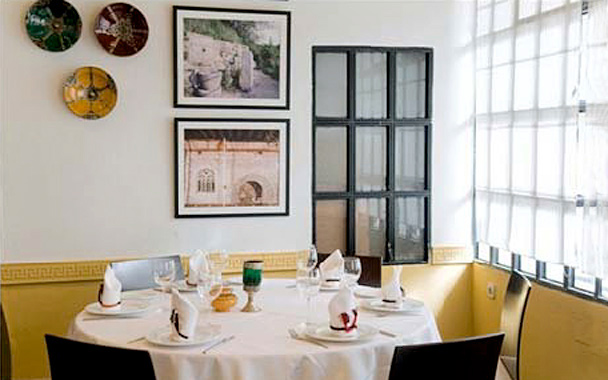Naomi Grill is probably the only restaurant in Madrid whose soundtrack careens giddily from “Hava Nagilah” to “If I Were a Rich Man.” It is certainly the only one that keeps a basket of yarmulkes on the bar. None of this would be remarkable in London or New York, but until about 30 years ago, there were hardly any Jews in Madrid. The fact that the city now has enough to support a kosher restaurant is noteworthy in itself. Just as noteworthy is the fact that the food is actually good.
For the previous lack of a good kosher restaurant in Madrid, blame the Inquisition. Although Spain was, in the Middle Ages, a thriving center for Jewish culture, centuries of persecution effectively cleared the country of openly practicing Jews, to say nothing of decent bagels. (Not that Spain’s Sephardic Jews ever ate bagels. But the complaint remains: There are no decent bagels in Madrid.)
It was not until Franco’s death in 1975 that Jews returned to Madrid in numbers. Today, an estimated 40,000 to 48,000 live in Spain. And on any weekday, some of them can be found eating lunch at Naomi Grill. The menu is Sephardic, like owner Giuseppe Gavizon himself, who recreates many of the dishes, he says, that his mother used to cook. Practically, though, those dishes turn out, like the restaurant’s décor, to be surprisingly Moroccan. Sit down, and the waiter brings small dishes of cumin-scented carrot and eggplant salads. The b’stilla (a kind of Moroccan potpie) is made with chicken instead of pigeon, but it was one of the best I have ever tasted, greaseless and perfectly balanced between sweet and savory. Tagines and couscous make up most of the main courses, though there is a chicken schnitzel on the menu for, one supposes, the occasional homesick Ashkenazi.
Gavizon himself lived for 25 years in Morocco. So did many of Spain’s Jews once they were expelled from the country back in 1492. “The Jews that went to Morocco had already adopted some degree of Muslim culinary culture, since the Muslims had ruled Spain for centuries. Once they were in Morocco, they picked up Berber customs too.” Which explains the crisp, almond-stuffed triangles that Naomi Grill soaks in honey and orange-flower water for dessert.
Get him talking, and Gavizon will point out other fusions as well. In fact, the most Madrileño of Madrid dishes, he says, came from Spain’s Jews. The meat-and-chickpea stew called cocido was originally a Jewish concoction that could be kept on a simmer from Friday night through Saturday, thereby obviating the need to light a fire, which is prohibited during the Sabbath. There is, however, no cocido on Naomi Grill’s menu. In the intervening centuries since those medieval purges of Jews (and Muslims for that matter), Spanish cooks loaded the dish with that most unkosher of foods: pork. And not just one form of pork, but many—bacon, blood sausage, chorizo—as if going out of their way to claim the dish for themselves.
So there’s something a little bit triumphant about the Naomi Grill. Five hundred years after the country expelled its Jews, this homey restaurant with its Moroccan-inflected cuisine is one more sign of how far Spain has come in the past few years. As is the fact that, as Gavizon says, nearly half his customers are non-Jewish Spaniards. “They just like the food,” he shrugs.




 Pinterest
Pinterest


